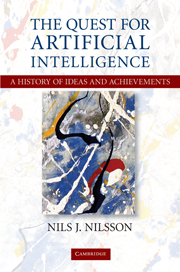Book contents
- Frontmatter
- Contents
- Preface
- PART I BEGINNINGS
- PART II EARLY EXPLORATIONS: 1950S AND 1960S
- 3 Gatherings
- 4 Pattern Recognition
- 5 Early Heuristic Programs
- 6 Semantic Representations
- 7 Natural Language Processing
- 8 1960s' Infrastructure
- PART III EFFLORESCENCE: MID-1960S TO MID-1970S
- PART IV APPLICATIONS AND SPECIALIZATIONS: 1970s TO EARLY 1980s
- PART V “NEW-GENERATION” PROJECT
- PART VI ENTR'ACTE
- PART VII THE GROWING ARMAMENTARIUM: FROM THE 1980s ONWARD
- PART VIII MODERN AI: TODAY AND TOMORROW
- Index
- Plate section
4 - Pattern Recognition
Published online by Cambridge University Press: 05 August 2013
- Frontmatter
- Contents
- Preface
- PART I BEGINNINGS
- PART II EARLY EXPLORATIONS: 1950S AND 1960S
- 3 Gatherings
- 4 Pattern Recognition
- 5 Early Heuristic Programs
- 6 Semantic Representations
- 7 Natural Language Processing
- 8 1960s' Infrastructure
- PART III EFFLORESCENCE: MID-1960S TO MID-1970S
- PART IV APPLICATIONS AND SPECIALIZATIONS: 1970s TO EARLY 1980s
- PART V “NEW-GENERATION” PROJECT
- PART VI ENTR'ACTE
- PART VII THE GROWING ARMAMENTARIUM: FROM THE 1980s ONWARD
- PART VIII MODERN AI: TODAY AND TOMORROW
- Index
- Plate section
Summary
Most of the attendees of the dartmouth summer project were interested in mimicking the higher levels of human thought. Their work benefitted from a certain amount of introspection about how humans solve problems. Yet, many of our mental abilities are beyond our power of introspection. We don't know how we recognize speech sounds, read cursive script, distinguish a cup from a plate, or identify faces. We just do these things automatically without thinking about them. Lacking clues from introspection, early researchers interested in automating some of our perceptual abilities based their work instead on intuitive ideas about how to proceed, on networks of simple models of neurons, and on statistical techniques. Later, workers gained additional insights from neurophysiological studies of animal vision.
In this chapter, I'll describe work during the 1950s and 1960s on what is called “pattern recognition.” This phrase refers to the process of analyzing an input image, a segment of speech, an electronic signal, or any other sample of data and classifying it into one of several categories. For character recognition, for example, the categories would correspond to the several dozen or so alphanumeric characters.
Most of the pattern-recognition work in this period dealt with two-dimensional material, such as printed pages or photographs. It was already possible to scan images to convert them into arrays of numbers (later called “pixels”), which could then be processed by computer programs such as those of Dinneen and Selfridge.
- Type
- Chapter
- Information
- The Quest for Artificial Intelligence , pp. 62 - 80Publisher: Cambridge University PressPrint publication year: 2009



